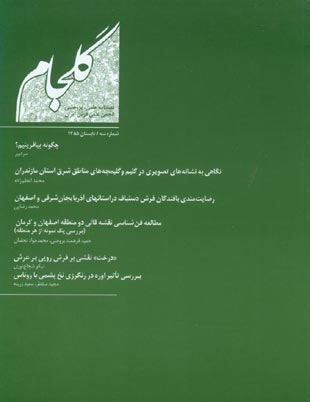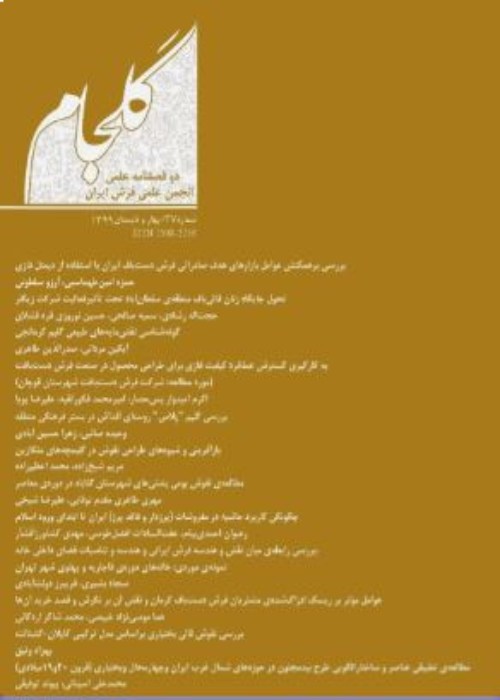فهرست مطالب

نشریه گلجام
پیاپی 3 (تابستان 1385)
- 112 صفحه، بهای روی جلد: 20,000ريال
- تاریخ انتشار: 1385/06/01
- تعداد عناوین: 8
-
-
صفحه 5
-
صفحه 11بافته های روستایی و به ویژه گلیمهای آن، حاصل تجربه ذوقی و خلاقیت شخصی است و در عین حال، تکامل و اصالت نقوش و رنگ آمیزی آن نتیجه یک روح جمعی است که در گذر زمان به شکوفایی رسیده است، به نظر می رسد گلیم و گلیمچه های روستاییان شرق مازندران این پیوند روح جمعی را در خود حفظ کرده است. بافندگان این مناطق در روند تکامل آثار خود، نه تنها از طبیعت تقلید صرف نکرده، بلکه به موازات آن نقشهای نوینی را ابداع نموده اند. از این رو شناخت دستاوردهای آنها به عنوان دستبافهای ساده و قابل حمل علاوه بر فراورده ای کاربردی، حاوی رمزهای پنهان و اشاراتی ورای زندگی مادی است که بررسی آنها جهت شناخت ایده ها، بینش و شیوه زندگی اهمیت ویژه ای دارد.کلیدواژگان: گلیم، گلیمچه، نقش گلیم، رنگ گلیم، بافنده، دستباف
-
صفحه 25این مقاله در پی بررسی میزان و عوامل موثر بر رضایت شغلی بافندگان فرش دستباف است که اطلاعات آن از طریق پرسشنامه طی تحقیقی در بین 834 نفر از بافندگان استانهای آذربایجان شرقی و اصفهان در سال 1382 جمع آوری شده است. در این تحقیق با تکیه بر الگوی نظری تلفیقی، نقش متغیرهای ذهنی و عینی در میزان بافندگان فرش مورد بررسی قرار می گیرد.کلیدواژگان: فرش، رضایت شغلی، سازمان تولید، عدالت توزیعی، هزبرگ، نظریه برابری، نظریه اختلاف
-
صفحه 35حفظ و نگهداری نقشه های قالی تابع تدوین طرح حفاظتی، مرمتی و علمی مناسب و دقیق آنهاست. مطالعات پژوهشی و فن شناسی درباره نقشه های قالی دو منطقه اصفهان و کرمان با هدف کلی دستیابی به یک طرح جامع و دقیق برای حفظ و مرمت آنها انجام گرفته است. در این پژوهش علاوه بر تفاوتهایی در تکنیک اجرای نقشه قالی دو منطقه، بر اساس مشاهده میکروسکوپی نوع الیاف کاغذ نقشه بدون تکیه گاه کرمان از چوب درختان کاج و صنوبر، الیاف مقوا و کاغذ نقشه قالی مقوایی کرمان از چوب درختان کاج و صنوبر و الیاف کاغذ نقشه قالی اصفهان از چوب درختان زبان گنجشک سفید و کاج شناسایی شد...
کلیدواژگان: فن شناسی، نقشه قالی، کاغذ، رنگ، رنگدانه -
صفحه 51نماد درخت یکی از قدیمیترین نقوشی است که مورد توجه بشر قرار گرفته و آن را در آثار هنری خویش به کار برده است. این نماد که بیشتر آن را به عنوان درخت مقدس و یا درخت زندگی می ستودند، از 3500 سال قبل از میلاد در نواحی بین النهرین و پس از آن ایران مورد توجه بوده است. حضور این نماد که با اشکال مختلف به کار گرفته می شده است، تا پس از ظهور اسلام نیز همچنین در آثار هنری به چشم می خورد، اما این بار نه به عنوان درخت زندگی و از دیدگاه اساطیری، بلکه در نقش آفریده با برکت خداوند، تسبیح کننده ذات اقدس الهی و نشانی از بهشت موعود...
کلیدواژگان: نقش گیاهان، درخت زندگی، فرش ایرانی، فرشهای محرابی درختی -
صفحه 67در این تحقیق اثر اوره در فرآیند رنگرزی نخ پشمی با روناس مورد مطالعه قرار گرفته است. اوره با درصدهای مختلف قبل، همزمان و بعد از رنگرزی به حمام رنگرزی اضافه شده و رفتار آن روی رنگرزی و لیف پشم مورد بررسی قرار گرفته است. آزمایشهای مختلف شامل تعیین میزان جذب رنگزا در زمانهای مختلف، جذب آهن فتیله ای، زمان غرق شدن، ثباتهای نوری و شستشویی و بررسی سطح الیاف با استفاده از میکروسکوپ الکترونی روی نمونه ها انجام شده است. نتایج نشان می دهد که اوره سبب افزایش سرعت جذب روناس شده است...
کلیدواژگان: پشم، اوره، روناس، رنگرزی
-
Page 11Village weavings, particularly flatwoven Gelims, are the products of personal lastes, gifts, and individual creativity. In the meantime, the genuineness of their designs and colors is rooted in a collective genius enriched over the centuries. This collective genius seems to be well-preserved in the flatweav of East Mazandaran villagers, whose design repertoire is not confined to sheer imitation of nature, but is rich in respect of motifs of their own. That is why their weavings stand as documents of their ideas and their way of life, besides being useful and easy to use and carry products.Keywords: Kilim, pattern, colour, hand waven.
-
Page 25This article argues that hand woven carpet - weavesrs’ job satisfaction is one of the most important factors that influences the quality of their works. Thus, it is proposed to study the degree of job satisfaction among them and some important factors which determine its variation. The scope of the research involved 834 carpet weavers in East Azarbaijan and Isfahan in 2004. in this research, a theoretical model based on objective and subjective variables has been applied.Keywords: Carpet-weavers', Job satisfaction, Organization of production, distributive justice, Hezberg, Theory of Equality
-
Page 35Conservation and preservation of carpet design cartoons requires a scientific con servation plan appropriate for each case study. The research into the carpet designs of Kerman and Isfahan regions was carried out in 2003 in order to gain access to a comprehensive and exact method for their conservation. In this research, besides the differences in the techniques of producing carpet designs in these regions - based on microscopic observations - the kind of paper fibers used in Kerman was realized as a pine wood byproduct, while the Isfahan region cartoon paper was from ashwhite and pine trees. The kind of dyes that have been used in colouring of carpet designs in Kerman and Isfahan was determined on the basis of the elemental analysis of SEM and FTIR spectrum. Subsequently, the organic origin of the following dyes was established: black, dark- blue, blue, red and the black ink of the checkered paper (manual and printed). The other dyes were mineral. The compound white colour in Kerman carpet designs was white lead and the compound white of Isfahan (except light blue) was zinc oxide.Keywords: technology, carpet desing, paper, colour, pigment
-
Page 51Since ancient times, “Tree” has been the focus of attention as a symbol, in works of art. In Mesopotamia and later in Iran, this symbol was known as a holy tree or tree of life as early as 3500 BC, and was delineated in different shapes. After the advent of Islam, this symbol prevailed in works of art; However, no longer as a mythological holy tree but rather standing for heavenly blessings and the paradise. This symbol has been used in different branches of art, including rugmaking. In the art of carpet patterning, the tree has prefigured a great variety of designs, notably the plant Mihrabi (prayer niche). No doubt, the predominance of the tree image in a large group of prayer rugs, is not accidental and must have an objective more than conveying mere beauty. One interpretion suggests an epitome of paradise. Given the Islamic restrictions imposed on the portrayal of human beings, a tree depicted in a prayer niche may well stand for a man in prayer.Keywords: plant's pattern_tree of life_Iran carpet_tree - mihrabi carpet.
-
Page 67The influence of urea as an additive in dyeing of wool with madder was evaluated in this work. A different concentration of urea was applied on wool yarns before, during and after dyeing of samples. The treated samples were tested for dye absorption at different time, wicking, sinking, wash and light fastness and surface morphology by scanning electronic microscope. The results show that urea is an effective additive in dyeing of wool by madder by increasing the dye absorption. Adding of urea ranging 50% to 250% on weight of fibers leads to swell the wool fibers however, increasing the urea percent to 300% may damage the fiber surfaces and reduces the fiber strength.Keywords: Wool, Madder, Urea, Dyeing, Dye absorption


